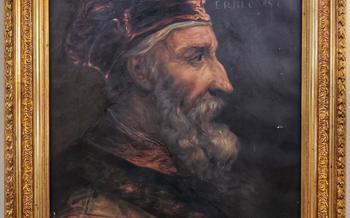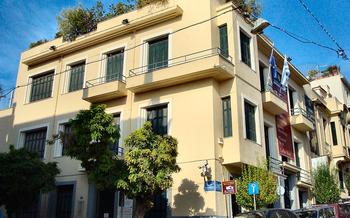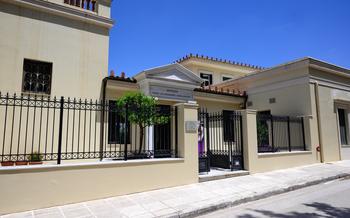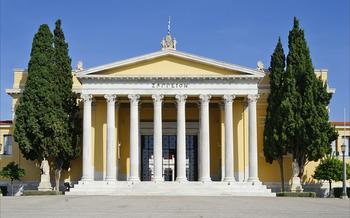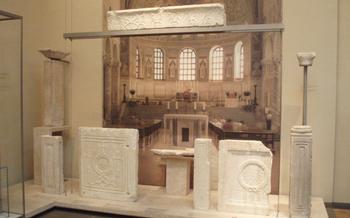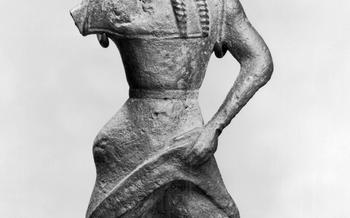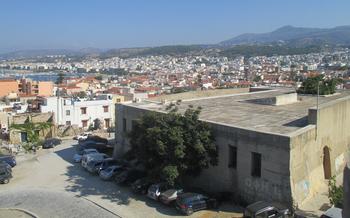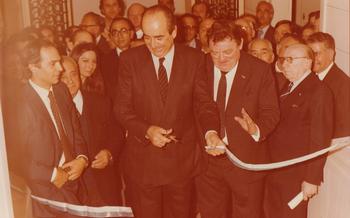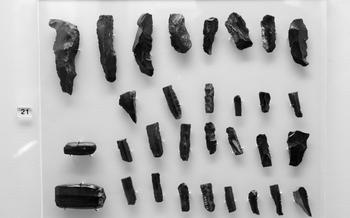
Benaki Museum
- Unveiling the Benaki Museum: A Journey Through Greek History and Culture
- Navigating the Museum's Collections: A Comprehensive Guide
- Ancient Greek Art: Unveiling the Masterpieces
- Byzantine Art: A Legacy of Splendor
- Post-Byzantine Art: A Bridge to the Modern Era
- Temporary Exhibitions: A Window to Contemporary Art
- Educational Programs: Engaging the Community
- Museum Shop: A Treasure Trove of Greek Souvenirs
- Exploring the Neighborhood: Beyond the Museum Walls
- Capturing the Essence: Photography and Social Media
- Accessibility and Inclusivity: Welcoming All Visitors
- Preservation and Conservation: Ensuring a Legacy
- Supporting the Museum: A Collective Endeavor
- Insider Tip: Hidden Gems and Secret Corners
Unveiling the Benaki Museum: A Journey Through Greek History and Culture
In the heart of Athens, nestled amidst the bustling streets of Kolonaki, stands the Benaki Museum, a treasure trove of Greek art and culture. Founded in 1930 by Antonis Benakis, a wealthy Greek benefactor and art collector, the museum has grown into one of the most important cultural institutions in Greece and a must-visit destination for anyone interested in exploring the rich history and heritage of this ancient land.
Housed in a magnificent neoclassical building, the Benaki Museum boasts an impressive collection of over 45,000 artifacts that span from prehistoric times to the present day. The museum's diverse holdings reflect the multifaceted nature of Greek civilization, showcasing everything from ancient sculptures and Byzantine icons to post-Byzantine paintings and contemporary art installations.
The Benaki Museum is not just a repository of artifacts; it is a living, breathing institution dedicated to preserving and promoting Greek culture. Through its comprehensive collection, innovative exhibitions, and educational programs, the museum offers visitors a unique opportunity to immerse themselves in the vibrant tapestry of Greek history and culture.
Navigating the Museum's Collections: A Comprehensive Guide
The Benaki Museum showcases an extensive array of artifacts and artworks organized into thematic sections, providing visitors with a comprehensive journey through Greek history and culture. The ancient Greek collection, spanning the Archaic to the Hellenistic period, features iconic sculptures, pottery, and jewelry that offer a glimpse into the mythology, religion, and daily life of ancient Greece.
Byzantine art is represented by a dazzling display of mosaics, icons, and illuminated manuscripts, showcasing the exquisite craftsmanship and deep religious devotion that characterized this era. The post-Byzantine collection encompasses a diverse range of works, including paintings, sculptures, and textiles, reflecting the artistic and cultural influences of the Venetian and Ottoman empires.
Interactive displays and multimedia presentations enhance the museum experience, providing visitors with deeper insights into the historical context and significance of the exhibits. The museum also offers guided tours, led by knowledgeable experts, who share their passion for Greek art and history, bringing the collection to life.
Furthermore, the museum is committed to accessibility for visitors with disabilities, offering wheelchair accessibility, ramps, and elevators throughout the building. Audio guides and tactile exhibits cater to visually impaired visitors, while sign language interpreters and multilingual resources are available for deaf and hard of hearing visitors, ensuring an inclusive and enriching experience for all.
Ancient Greek Art: Unveiling the Masterpieces
Peer into the captivating world of ancient Greek art at the Benaki Museum, where masterpieces from the Archaic and Classical periods await discovery. Iconic sculptures, such as the serene kore statues and the powerful kouroi, embody the essence of early Greek artistry. Marvel at the intricate details of pottery adorned with scenes from mythology and daily life, offering a glimpse into the beliefs and customs of ancient Greece.
The museum's collection of ancient Greek art is a testament to the civilization's unparalleled achievements in the realm of aesthetics. Explore the fascinating mythology depicted in these works, where gods and goddesses, heroes and monsters, intertwine in epic tales. Delve into the everyday lives of ancient Greeks, their rituals, celebrations, and domestic scenes, vividly captured in ceramic masterpieces.
Ancient Greek art transcended mere aesthetics, serving as a powerful tool for storytelling, education, and religious expression. Through these remarkable creations, the ancient Greeks communicated their values, beliefs, and aspirations, leaving an indelible mark on Western civilization. Compare and contrast these works with art from other ancient civilizations, such as Egypt, Mesopotamia, and Persia, to gain a deeper appreciation for the unique contributions of ancient Greece to the global artistic landscape.
Byzantine Art: A Legacy of Splendor
Peer into the dazzling world of Byzantine art at the Benaki Museum, where exquisite mosaics, icons, and illuminated manuscripts narrate the grandeur of an empire that spanned over a millennium. From the ethereal beauty of the Virgin Mary depicted in icons to the intricate mosaics adorning the walls of churches, Byzantine art exudes a divine radiance that transports visitors to a realm of spiritual transcendence.
The influence of Christianity permeates every fiber of Byzantine art, imbuing it with a profound sense of devotion and mysticism. Through the masterful hands of Byzantine artists, biblical scenes and religious figures come alive, inviting viewers to contemplate the sacred and the divine. The fusion of Eastern and Western traditions in Byzantine art creates a unique blend of aesthetics, where the classical heritage of Greece merges harmoniously with the spiritual traditions of the East.
Marvel at the intricate details of mosaic masterpieces, where millions of tiny tesserae coalesce to form vibrant and lifelike images. Gaze upon the haunting expressions of saints and angels, their eyes seemingly following your every move, evoking a sense of awe and reverence. The interplay of light and shadow in these mosaics creates a mesmerizing effect, transforming the museum's walls into radiant canvases of devotion.
Byzantine art stands as a testament to the empire's cultural and artistic achievements, transcending religious boundaries to leave an indelible mark on Western civilization. Its enduring legacy continues to inspire and captivate audiences worldwide, a testament to the enduring power of faith and artistic expression.
Post-Byzantine Art: A Bridge to the Modern Era
The fall of the Byzantine Empire in 1453 marked a significant turning point in the history of Greek art. The subsequent centuries witnessed the rise and fall of Venetian and Ottoman rule, each leaving an indelible imprint on the artistic landscape of Greece.
The post-Byzantine period saw a gradual transition from the Byzantine style to a more naturalistic approach, influenced by the Renaissance and Baroque movements in Western Europe. Notable artists of this period include El Greco, a Cretan-born painter who achieved fame in Spain, and Theophanes the Cretan, an icon painter who worked extensively in Crete and Mount Athos.
Venetian rule, particularly in the Ionian Islands, brought with it a strong influence from Italian Renaissance art. This influence is evident in the works of artists such as Nikolaos Kallergis, who incorporated elements of both Byzantine and Italian styles in his paintings.
Ottoman rule, on the other hand, had a more complex impact on Greek art. While the Ottomans generally discouraged figurative representation, they allowed for a flourishing of decorative arts, such as ceramics, textiles, and metalwork. This period also saw the emergence of a distinctive style of folk art, characterized by its vibrant colors and intricate designs.
The post-Byzantine period culminated in the Greek War of Independence in the early 19th century. This struggle for independence was accompanied by a revival of interest in Greek history and culture, which found expression in the art of the period. Notable artists of this time include Konstantinos Volanakis, a marine painter who depicted scenes from the Greek War of Independence, and Nikolaos Gyzis, a Munich-trained artist who played a key role in the development of modern Greek painting.
The post-Byzantine period was a time of transition and transformation for Greek art, as it navigated the influences of different cultures and laid the foundation for the emergence of modern Greek art.
Temporary Exhibitions: A Window to Contemporary Art
The Benaki Museum is not only a custodian of the past but also a vibrant platform for contemporary artistic expression. Temporary exhibitions are a key part of the museum's mission to engage with the present and showcase the diverse talents of Greek and international artists. These exhibitions explore a wide range of themes, from social and political issues to new artistic trends and technologies.
The museum collaborates with other institutions, artists, and curators to bring these exhibitions to life. The result is a dynamic and ever-changing program that reflects the pulse of contemporary art.
Temporary exhibitions at the Benaki Museum are often interactive and participatory, inviting visitors to engage with the artwork on a deeper level. Installations, multimedia presentations, and hands-on activities create a multisensory experience that makes art accessible and enjoyable for visitors of all ages.
These exhibitions provide a unique opportunity to see cutting-edge contemporary art in the context of a historical museum. They challenge traditional notions of art and history, and encourage visitors to think critically about the world around them. Whether you are a seasoned art enthusiast or a casual visitor, the Benaki Museum's temporary exhibitions are sure to offer a stimulating and thought-provoking experience.
Educational Programs: Engaging the Community
The Benaki Museum recognizes the importance of education and outreach in fostering a deeper understanding and appreciation of Greek art and culture. To this end, the museum offers an array of educational programs and initiatives that cater to visitors of all ages and backgrounds.
Workshops, lectures, and guided tours are regularly organized to provide visitors with in-depth insights into the museum's collection and the broader context of Greek history and culture. These programs are led by experienced educators and docents who share their knowledge and expertise in a lively and engaging manner.
The museum also places a strong emphasis on school programs, recognizing the importance of introducing young minds to the richness and diversity of Greek art. Guided tours, interactive workshops, and educational materials are tailored to different age groups, helping students develop a lifelong appreciation for their cultural heritage.
Outreach programs extend the museum's reach beyond its walls, bringing the collection and educational resources to underserved communities. These initiatives include mobile exhibitions, pop-up displays, and collaborations with local organizations to ensure that everyone has the opportunity to engage with Greek art and culture.
In addition, the museum's website and social media platforms offer a wealth of educational resources, including online exhibitions, virtual tours, and downloadable materials. These resources provide a convenient and accessible way for individuals around the world to learn about Greek art and history, regardless of their location or circumstances.
Through its comprehensive educational programs, the Benaki Museum plays a vital role in fostering a vibrant and engaged community of learners, promoting cultural literacy, and ensuring that the legacy of Greek art and culture continues to inspire and enrich future generations.
Museum Shop: A Treasure Trove of Greek Souvenirs
The Benaki Museum's gift shop is not just a place to buy souvenirs; it's an extension of the museum experience, offering a curated selection of items that reflect the museum's diverse collections and celebrate Greek culture. From exquisite replicas of ancient artifacts to contemporary Greek crafts, the museum shop is a treasure trove of unique and meaningful souvenirs.
Art lovers can find high-quality reproductions of iconic sculptures, pottery, and jewelry from the museum's ancient Greek and Byzantine collections. These replicas are meticulously crafted using traditional techniques, ensuring that they are faithful to the originals.
For those who prefer contemporary art, the museum shop offers a variety of pieces by talented Greek artists, including paintings, sculptures, and ceramics. These works are often inspired by Greek mythology, history, and culture, providing visitors with a unique opportunity to take home a piece of contemporary Greece.
In addition to art and replicas, the museum shop also offers a range of books, catalogs, and postcards featuring the museum's collection. These publications are a great way to learn more about Greek art and history and to share your museum experience with friends and family.
By purchasing souvenirs from the Benaki Museum's gift shop, you are not only taking home a piece of Greece, but also supporting the museum's mission to preserve and promote Greek culture. Every purchase contributes to the museum's educational programs, conservation projects, and exhibitions, ensuring that future generations can continue to enjoy and learn from Greece's rich cultural heritage.
Exploring the Neighborhood: Beyond the Museum Walls
Venturing beyond the walls of the Benaki Museum, visitors will discover a vibrant neighborhood steeped in history and culture. A short stroll away lies the National Archaeological Museum, a treasure trove of ancient Greek artifacts, including the iconic gold Mask of Agamemnon and the Antikythera Mechanism, an ancient astronomical calculator. The University of Athens, founded in 1837, is another architectural gem, showcasing neoclassical buildings and a botanical garden.
The Kolonaki neighborhood, where the museum is situated, is a charming blend of old and new. Historic landmarks, such as the Byzantine Church of Agios Dionysios Areopagitis, stand alongside modern boutiques, art galleries, and trendy cafés. Visitors can immerse themselves in the vibrant atmosphere, savor delicious Greek cuisine at traditional tavernas, or shop for unique souvenirs and handicrafts.
To fully experience the neighborhood's cultural offerings, consider embarking on a leisurely walking tour. Start at the Benaki Museum, and head towards the National Garden, a tranquil oasis in the heart of the city. Continue your stroll along Vasilissis Sofias Avenue, admiring the stately buildings and monuments that line this grand boulevard. The Panathenaic Stadium, the only stadium in the world built entirely of marble, is a must-see for history buffs.
Whether you prefer to wander aimlessly or follow a structured itinerary, exploring the neighborhood surrounding the Benaki Museum is an enriching experience that offers a glimpse into the diverse cultural tapestry of Athens.
Capturing the Essence: Photography and Social Media
The Benaki Museum encourages visitors to capture their experiences and share them with the world through photography and social media. Photography is allowed in most areas of the museum, with the exception of a few temporary exhibitions where photography may be restricted to protect sensitive works of art. Visitors are reminded to be respectful of other visitors and to avoid using flash photography, which can damage the artifacts.
To ensure the best photo opportunities, it is advisable to visit the museum during the morning when the natural light is at its best. For those who wish to share their photos on social media, the museum encourages the use of the hashtag #BenakiMuseum. This hashtag allows visitors to connect with each other and share their experiences, creating a vibrant online community of art enthusiasts.
The museum's official social media accounts on platforms such as Facebook, Instagram, and Twitter provide a wealth of information and insights into the museum's collection, upcoming exhibitions, and educational programs. Visitors are encouraged to follow these accounts to stay up-to-date with the latest news and events, and to engage with the museum's community online.
By capturing and sharing your experiences at the Benaki Museum, you not only create lasting memories but also contribute to the museum's mission of promoting Greek art and culture to a global audience.
Accessibility and Inclusivity: Welcoming All Visitors
The Benaki Museum is committed to providing an accessible and inclusive environment for all visitors, regardless of their abilities or disabilities. The museum features wheelchair accessibility, ramps, and elevators to ensure that all visitors can navigate the museum's spaces with ease. Audio guides and tactile exhibits are available for visually impaired visitors, allowing them to experience the museum's collection in a meaningful way. Sign language interpreters and multilingual resources are also provided for deaf and hard of hearing visitors, ensuring that they can fully participate in guided tours and educational programs.
The Benaki Museum recognizes that accessibility and inclusivity are essential for creating a welcoming and enriching experience for all visitors. By providing a variety of accessibility features and resources, the museum strives to ensure that everyone can engage with and appreciate the treasures of Greek history and culture. The museum's commitment to accessibility extends beyond physical barriers, as it also offers educational programs and resources designed to cater to visitors with diverse learning styles and needs.
Preservation and Conservation: Ensuring a Legacy
The Benaki Museum is not only a showcase of Greek history and culture but also a steward of its preservation and conservation. Recognizing the immense value of its collection, the museum has implemented rigorous measures to ensure that these cultural treasures remain intact for future generations.
Conservation experts meticulously assess and document each artifact's condition, utilizing state-of-the-art techniques to stabilize and restore delicate materials. Environmental controls, such as climate regulation and lighting, are carefully monitored to minimize deterioration. The museum also collaborates with other institutions and experts to share knowledge and expertise in conservation practices.
Beyond the physical preservation of artifacts, the Benaki Museum actively participates in research projects to deepen understanding of the materials, techniques, and history of the objects in its collection. This research not only informs conservation decisions but also contributes to the broader field of art history and archaeology.
The museum's commitment to preservation and conservation extends beyond its own walls. It actively advocates for the protection of cultural heritage at national and international levels, participating in conferences, workshops, and collaborations to promote best practices and raise awareness of the importance of preserving our shared cultural legacy.
Supporting the Museum: A Collective Endeavor
The Benaki Museum, like many cultural institutions, relies on the support of the community to continue its important work. There are several ways in which you can contribute to the museum's mission and ensure the preservation and promotion of Greek cultural heritage.
One way to support the museum is through membership. Members receive a range of benefits, including free or discounted admission, invitations to special events, and access to exclusive content and resources. Donations are another vital source of support for the museum. Your contributions help to fund exhibitions, educational programs, and conservation projects. You can also support the museum by becoming a sponsor or volunteering your time. Sponsorship opportunities range from supporting specific exhibitions to providing funding for educational initiatives. Volunteers play a crucial role in the museum's operations, assisting with tasks such as visitor services, educational programs, and special events.
By supporting the Benaki Museum, you are investing in the preservation of Greece's rich cultural heritage and ensuring that future generations can continue to learn from and appreciate the treasures it holds.
Insider Tip: Hidden Gems and Secret Corners
Beyond the well-known highlights, the Benaki Museum holds a treasure trove of hidden gems waiting to be discovered. One such gem is the "Secret Room", tucked away on the museum's top floor. This intimate space showcases a collection of exquisite Byzantine jewelry, including intricate gold necklaces, earrings, and rings, offering a glimpse into the opulence and craftsmanship of the Byzantine era.
For a moment of tranquility, seek out the "Inner Courtyard", a serene oasis hidden amidst the museum's bustling halls. Surrounded by lush greenery and adorned with ancient sculptures, this secluded spot invites visitors to pause and reflect on the museum's rich history and collections.
To capture a truly unique perspective, head to the "Rooftop Terrace" for panoramic views of Athens and the Acropolis. This elevated vantage point offers a breathtaking backdrop for your museum photos, allowing you to capture the essence of the city's ancient and modern spirit in a single frame.
To avoid the crowds and enjoy a more intimate museum experience, plan your visit during the "Early Morning Hours". As the doors open, you'll have the chance to wander through the galleries in relative solitude, savoring the tranquility and gaining a deeper appreciation for the museum's treasures without the distractions of large crowds.
